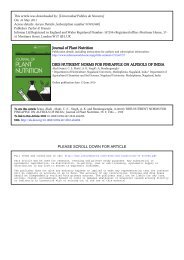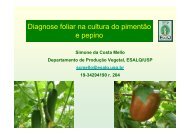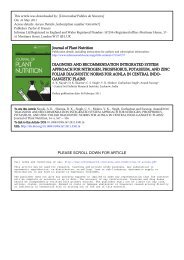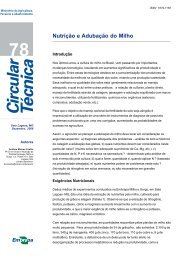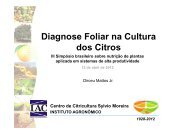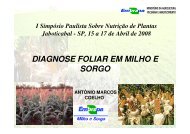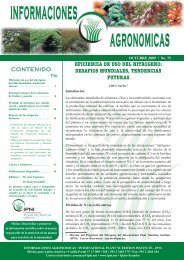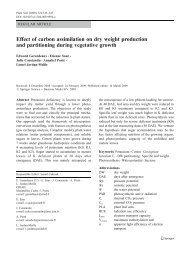Download PDF - Nutricao de Plantas
Download PDF - Nutricao de Plantas
Download PDF - Nutricao de Plantas
Create successful ePaper yourself
Turn your PDF publications into a flip-book with our unique Google optimized e-Paper software.
160 Plant Soil (2008) 304:157–168Control of environmental conditionsThe inci<strong>de</strong>nt photosynthetically active radiation (PAR)was measured in the greenhouse using three amorphoussilicon cells (Solems, Palaiseau, France) as proposed byChartier et al. (1989). Air relative humidity wasmeasured with a relative humidity probe (HMP35AC,Vaisala, Helsinki, Finland). Air temperature wasmeasured using temperature probes (107, Campbellscientific, UK). All sensors were connected to adatalogger (21X, Campbell Scientific, UK). Measurementswere ma<strong>de</strong> every 15 min, but only hourlyaverage values were recor<strong>de</strong>d. Thermal time (TT in °Cdays) was calculated on a daily basis as follows:TT ¼ ðT max þ T min Þ=2 T bwhere T max and T min are the maximum and minimumhourly air temperature (in °C), respectively, and T b thebase temperature (10°C). Cumulative thermal time wascalculated by adding daily values.Average daily values of air temperature, inci<strong>de</strong>ntPAR and air relative humidity during the experimentwere 18.6°C, 8.3 MJ m −2 and 71%, respectively. Theaverage daily inci<strong>de</strong>nt PAR was relatively low sincethe experiment was carried out in October withoutadditional artificial light.CalculationsLeaf areaAreas (A, inm 2 ) of individual leaves were calculatedas followed (Bonhomme et al. 1982):A ¼ 0:75 L W for fully expan<strong>de</strong>d ðligulatedÞleavesA ¼ 0:5 L W for expanding leavesThe total leaf area per plant (LA in m 2 ) wascalculated by adding all individual leaf areas.Photosynthetically active radiation absorbed by plantsThe daily amount of PAR absorbed by plants (PARa, inMJ) was calculated as the product of the daily inci<strong>de</strong>ntPAR (in MJ m −2 ) and the total leaf area per plant (inm 2 ). Leaf absorbance is supposed to be equal to 1.Self-shading and mutual shading between plants wereneglected because of the low total area per plant andthe large distance between plants (approximately 1plant m −2 ). For daily calculations the leaf area per plantwas linearly interpolated between sampling dates.Radiation use efficiencyThe radiation use efficiency (RUE, in g MJ −1 ) wascalculated for each interval between sampling dates asfollows:RUE ¼ ðW n W n 1 Þ= ðcPARa n cPARa n 1 Þwith W n and W n−1 being the average plant dry biomass(in g) on dates n and n−1, respectively, and cPARa nand cPARa n−1 being the cumulated amount of PARabsorbed by the plant (MJ) on dates n and n−1respectively. Since RUE was calculated from averageplant biomass and absorbed PAR increments at theplant population level no replications were availableand no statistical tests could be performed on thisvariable.Leaf elongation rate (LER)The general shape of the curve of a maize leaf bla<strong>de</strong>length against thermal time from its initiation is sigmoid(Arkebauer and Norman 1995; Duran<strong>de</strong>tal.1995).The elongation rate gradually increases, levels out(quasi-linear elongation phase) and then gradually<strong>de</strong>creases. The first phase of elongation occurs whenthe leaf is hid<strong>de</strong>n by the sheaths of the lower leaves. Tomake the comparison easier between LER of differentleaf ranks and K treatments, we calculated the LERduring the quasi-linear elongation phase only. Onlydata when the leaf was between 20% and 90% of itsfinal leaf length were consi<strong>de</strong>red for LER calculations.For each leaf rank and K treatment the mean LER (inmm °C days −1 ) was calculated as the slope of leaflength against cumulative thermal time.Axile root elongation rate (RER)The root elongation rate (RER in mm °C days −1 )ofaxile roots was calculated using the successive inkmarks as proposed by Mollier and Pellerin (1999):RER ¼ðΔL br þ L unbr n L unbr n 1 Þ= ðTT n TT n 1 Þwith ΔL br being the distance (in mm) between the inkmarks drawn on the root on days n and n−1, L unbr n
Plant Soil (2008) 304:157–168 161and L unbr n − 1 being the length of the apicalunbranched zone on days n and n−1 and TT n andTT n−1 being the cumulated thermal time on days nand n−1.Statistical testsFor most of the measured variables, analysis ofvariance was carried out for each day with Ktreatment being the only factor. Means were separatedusing the Least Squares Means Difference Stu<strong>de</strong>nt'sTest at the P=0.05 and 0.01 significance levels.Statistical tests were performed using the JMP® V5software.ResultsPlant chemical composition and water contentK concentration, expressed on a tissue water basis,was close to 100 mM during the whole experiment forK+ plants, whereas it <strong>de</strong>clined steadily and dropped toabout 30 mM at the end of the experiment for K-<strong>de</strong>prived plants (Fig. 1). K concentrations weresignificantly lower in K-<strong>de</strong>prived plants from the firstCations concentration (mM)160140120100806040200K0K+∑cations K0∑cations K+-50 0 50 100 150 200 250Thermal time since starvation (°C days)Fig. 1 K concentration and total concentration in cations(K+Ca+Mg+Na) in plant tissue water (in mM) as a functionof thermal time after starvation, for treatments K0 and K+(means±standard <strong>de</strong>viation)sampling date after K <strong>de</strong>privation (27.6°C days) tillthe end of the experiment. K concentrations were 10–15 mM lower in roots than in shoots and thisdiscrepancy was more pronounced for K-<strong>de</strong>privedplants (data not shown). When expressed on a drymatter basis the K concentration in plants was about0.06 g g −1 in K+ plants whereas it dropped to about0.01 g g −1 in K0 plants at the end of the experiment.The water content in plant tissues was significantlylower for K-<strong>de</strong>prived plants from the third samplingdate after K <strong>de</strong>privation (97.4°C days), in shoots butnot in roots (data not shown). The relative value ofshoot water content (shoot water content in K0/shootwater content in K+) <strong>de</strong>clined steadily and reached0.95 at the end of the experiment. Therefore, thedifference between K treatments in K concentrationswas more pronounced when expressed on a drymatter basis (K concentration in plants of K0 plants/K concentration in plants of K+ plants=0.25 and 0.17at the end of the experiment when expressed on atissue water and a dry matter basis, respectively). Ca,Mg and Na concentrations were significantly higherin K-<strong>de</strong>prived plants (data not shown). This increasewas in part due to a net increase in their uptake, andthus <strong>de</strong>position rate (data not shown). But thecalculated sum of cations concentration expressedtowards tissue water (K, Ca, Mg and Na, ad<strong>de</strong>d un<strong>de</strong>rthe assumption that all these cations were un<strong>de</strong>r asoluble form) was however significantly lower in K<strong>de</strong>prived plants (Fig. 1). This suggests that the higheruptake of other cations (Ca, Mg, Na) by K <strong>de</strong>privedplants did not fully compensate the reduced molaritydue to the lower K content.Plant stages, biomass accumulation and radiationuse efficiencyThe number of visible leaves, the number ofexpan<strong>de</strong>d leaves and the number of phytomerscarrying axile roots were slightly lower for K0 plantsat the end of the experiment (−0.5 leaves and −0.5phytomer carrying axile roots). The differencesbetween K treatments were statistically significant atthe last sampling date only. The dry matter accumulationin shoots and roots was significantly reduced byK <strong>de</strong>privation from the fourth sampling date (119°Cdays) after <strong>de</strong>privation (Fig. 2). At the end of theexperiment, the relative plant dry biomass (plant drybiomass in K0/plant dry biomass in K+) was 0.57.
162 Plant Soil (2008) 304:157–168Dry matter (g.plant -1 )7654321K+ rootsK0 rootsK+ shootsK0 shoots0-50 0 50 100 150 200 250Thermal time since starvation (°C days)Fig. 2 Roots and shoots dry matter (in g per plant) as afunction of thermal time after starvation for treatments K0 andK+ (means±standard <strong>de</strong>viation)Shoots and roots were affected similarly, so that theroot biomass/plant biomass ratio was not stronglyaltered. It was however slightly higher for K0 plantsjust after K <strong>de</strong>privation (between the 5th and 7thvisible leaf stages) and became slightly lower later on(Fig. 3). If compared day by day, the root biomass/R / (R+S)0.450.400.350.300.250.200.154 5 6 7 8 9 10Plant stage (number of visible leaves)Fig. 3 Ratio between the root dry biomass (R) and the totalplant dry biomass (R+S), as a function of the plant stage(number of visible leaves) for treatments K0 and K+ (means±standard <strong>de</strong>viation)K-K+plant biomass ratio was significantly higher for the K-<strong>de</strong>prived plants at the third sampling date (97.4°Cdays) and significantly lower at the sixth sampling date(196.8°C days). Although no statistical tests could beperformed, the calculated values of RUE were verysimilar for K0 and K+ treatments for the twocalculation periods just after K starvation, whereasthey differed strongly later on (Fig. 4).Leaf elongation ratesWhen expressed on a daily basis (in mm per day) theleaf elongation rates were linearly related to airtemperatures (R 2 >0.8, data not shown). This resultconfirms that leaf elongation is strongly controlled bytemperature and emphasises the value of expressingleaf elongation rates on a thermal time basis (Ben-Haj-Salah and Tardieu 1995). Significant correlationswere also observed between LER expressed on athermal time basis and the inci<strong>de</strong>nt PAR accumulatedduring the 3 days preceding the leaf elongationmeasurement (0.34
Plant Soil (2008) 304:157–168 163Table 1 Values of leaves elongation rates (mm °C days −1 )ofeach leaf rank for both treatmentsLeaf rank K0 treatment K+ treatmentLER (mm)LER (LER for K0/LER for K+) versus thermal timeafter starvation for leaves 4 to 8. Average LER duringthe quasi-linear elongation phase were significantlylower in the K0 treatment for leaves 5 to 8 (Table 1).The relative LER <strong>de</strong>creased steadily from K starvationuntil the end of the experiment, with a final valueclose to 0.7. Values corresponding to the successiveleaves partially overlapped, which suggests that twosuccessive leaves elongating simultaneously weresimilarly affected by K <strong>de</strong>ficiency (Fig. 5).Axile root elongation rates and branchingLER (mm)4 n.s. 0.49±0.02 0.51±0.065** 0.53±0.03 0.61±0.046** 0.6±0.03 0.73±0.037** 0.58±0.04 0.76±0.028** 0.54±0.02 0.78±0.04* and ** indicate significance at p
164 Plant Soil (2008) 304:157–168Relative values of Root Elongation Rates (K0/K+)1.61.41.210.80.6P2P3P40.40 50 100 150 200Thermal time since starvation (°C days)Fig. 7 Relative value of the root elongation rate (RER in K0/RER in K+), for axile roots from phytomers P2, P3 and P4, as afunction of thermal time after starvationsignificantly lower for K0 plants at the end of theexperiment: 1.36 and 1.14 mm for axile roots ofphytomer 3, 1.72 and 1.34 mm for axile roots ofphytomer 4, for treatments K+ and K0, respectively.The <strong>de</strong>lay between lateral root initiation an<strong>de</strong>mergence was calculated as the slope of therelationship between the length of the apical unbranchedzone (L unbr ) and the axile root elongationrate (RER), as proposed by Pellerin and Tabourel(1995). It was not significantly different between Ktreatments (54 <strong>de</strong>gree-days for both treatments). The<strong>de</strong>nsity of branching (number of first-or<strong>de</strong>r lateralroots per unit length of axile root) was slightly higherfor K0 plants, but the length of laterals of similar agewere generally significantly lower (see Table 2 forphytomer 3; the same trends were observed on otherphytomers). However, as mentioned previously,measurements on laterals were only possible on thosewhich had emerged during the last 10 days of theexperiment, so that no data were available on lateralswhose growing period occurred just after K starvation.Soluble sugar and starch concentrations in leavesand root apicesThe concentrations of soluble sugars measured in theroot apical zones were generally greater for the K0treatment (Table 3), although the difference was notalways significant. Glucose was the most abundantsugar (>70%), followed by fructose. No significantdifference was observed between K treatments in thesoluble sugar and starch content in mature leaves.DiscussionK concentrations observed in plants of the K+treatment compare well with, but are in the lowerrange of values reported by other authors for plantswell supplied with K. Classical values reported in theliterature range between 150–250 mM (40–60 mgKg −1 dry matter) (Koch and Estes 1975; Huber 1985;Leigh 1989; Barraclough and Leigh 1993). Valuesobserved in K-<strong>de</strong>prived plants at the end of theexperiment are close to or slightly below the criticalvalues reported in the literature for maximum growthTable 2 Density, length and diameter of first-or<strong>de</strong>r laterals on axile roots of phytomer 3, for 20 mm axile root segments observed atthe last sampling dateTT since starvation Age of laterals Density K0 Density K+ Length K0 Length K+ Diameter K0 Diameter K+°C days °C days (cm −1 ) (cm −1 ) (mm) (mm) (mm) (mm)185.6 10.6 14.6±2.2* 9.3±2.4 3.50±0.7* 4.90±0.7 0.34±0.05 0.39±0.1175.1 21.1 16.4±3.9 10.8±3 5.80±1.1* 8.72±1.2 0.31±0.02 0.5±0162.7 33.5 9.5±4.3 8.8±2.5 12.52±4.2 23.52±8.6 0.3±0.04** 0.41±0.03124.7 71.5 11.1±2.5 10.9±3.0 12.56±3.2** 32.11±8.1 0.28±0.03 0.31±0.05110.6 85.6 11.1±2.1 13.2±3.9 12.73±2.2** 30.67±4.5 0.3±0 0.3±0.0399.4 96.8 11.3±0.3* 7.9±1.5 14.04±2.4* 38.49±7.6 0.28±0.02 0.35±0.06The first column states the thermal time since starvation when lateral emerged on the root segment, whereas the second column statesfor the age of laterals when measured. * and ** indicate significance at p
Plant Soil (2008) 304:157–168 165Table 3 Soluble sugar content in roots apex and leaf disks, and starch in leaf disks, for both treatmentsTT since starvation °C days B10 Soluble sugars in roots Soluble sugars in leaves Starch in leavesg 100 g dry matter −1 g 100 g dry matter −1 g 100 g dry matter −1K0 K+ K0 K+ K0 K+−9.0 7.3±0.9 6.8±1.7 0.4±0.127.6 20.1±5.0 15.3±3.1 8.0±5.0 11.8±10 2.2±0.5 2.3±0.756.4 18.4±0.3** 13.5±0.9 6.0±4.1 7.7±2.1 1.5±0.6 1.1±097.4 17.4±2.8 14.1±1.6 4.3±1.9 5.4±1.9 0.6±0.5 0.6±0.7119.2 21.0±2.1* 14.4±3.0160.1 17.4±3.3 11.0±3.0 4.8±1.0 5.5±1.2 0.2±0.1 0.5±0.3196.8 15.7±1.1 14.4±0.5 5.5±1.3* 2.5±0.3 0.7±0.4 0.2±0.1* and ** indicate significance at p
166 Plant Soil (2008) 304:157–168Table 4 Relative (K0/K+) growth (leaves, axile and lateral roots) and physiological (RUE, water content, sugar content) responses toK <strong>de</strong>ficiency, towards thermal time, stage and K concentration in starved plantsThermal Visible [K] intime afterstarvationleafstagePlantDM K0[K] in plant waterLeafElongationRateRoot Elongation Rate RUE Water contentSoluble sugars˚C days g.g -1 1 0.9 0.7 0.5 0.3 0.1 1 0.9 0.8 0.7 1.2 1.1 1 0.9 0.8 0.7 0.6 0.5 0.4 1 0.9 0.8 0.7 1 0.99 0.98 0.97 0.96 0.95 1.6 1.5 1.4 1.3 1.2 1.1 1 0.9 0.8 0.730 5,0 0.04 + + + +60 5.9 0.034 + + + +90 6.8 0.018 + + . + +120 7.8 0.015 + + . + +150 8.7 0.011 + + . + +180 9.6 0.009 + + . +leaves+ axile roots. lateral roots+ leaves + axile rootsMain gross tendanciesvalues of K0/values of K+) for most of thesevariables. On the whole, the plant response patternduring the initial period (mo<strong>de</strong>rate K <strong>de</strong>ficiency) maybe interpreted as the consequence of an initial effectof K <strong>de</strong>ficiency on the ability of leaf growing zone toexpand correctly. Conversely, photosynthetic processesdon't seem to be affected. According to Lockart(1965), cell growth is controlled by turgor pressureand cell wall extensibility. Potassium is involved inthe control of both processes, so that the observedreduced leaf elongation may be the consequence ofaltered cell-wall properties, osmotic and turgor pressures(Triboulot et al. 1997). These unfavourablebiophysical conditions are not likely to affect the rootcompartment, especially in our hydroponic conditions(Sharp et al. 1988, 1990), whereas roots are likely toget more carbohydrates from shoots since theirutilisation in aerial parts is limited by the reducedleaf growth. This latter interpretation is supported byfour observations (1) root elongation was stimulatedbetween 45 and 75 <strong>de</strong>gree-days, whereas leaf elongationwas reduced, (2) this stimulation was associatedwith an increased soluble sugar content. Thishigher sugar content may contribute to osmoticpotential and provi<strong>de</strong> carbon for growth, (3) in ourexperimental conditions (low inci<strong>de</strong>nt PAR) rootgrowth was likely to be limited by C, which isconfirmed by the existence of correlations betweenRER and inci<strong>de</strong>nt PAR, (4) the RUE was not affectedby K treatments during the first part of the experiment,which suggests that net carbon assimilation perunit leaf area was not reduced, but its allocationbetween shoots and roots was altered, as confirmedby the root biomass/plant biomass ratio. This “unfavourablebiophysical conditions” hypothesis and itsassociated effects on carbon allocation, which seemssufficient to account for the plant response during thefirst part of the experiment, however failed to explainwhat happened during the second part of theexperiment. The root elongation was reduced, bothon axile roots and to a greater extent on first-or<strong>de</strong>rlateral roots, and the RUE was severely reduced,which suggests that net carbon assimilation per unitleaf area was affected. Other physiological processesare likely to be affected, possibly due to thebiochemical functions of K.Theoritical K concentration in cell compartments (mM)120100806040200[K]vacuole[K]cytoplasmRelative DM0 10 20 30 40 50 601.21.00.80.60.40.20.0K content in dry matter (mg . kg -1 )Fig. 8 Relative dry matter yield (DM K0/DM K+) andcalculated concentrations of K in the cytoplasm and vacuoleas a function of K content in the dry matter (mg kg −1 ). Figureadapted from Leigh and Wyn Jones 1984, with the assumptionsthat [K] cyt =101 mM, [K] min vac =19 mM and that the proportionof intracellular volume occupied by the cytoplasm is 10%Dry matter K0 / K+
Plant Soil (2008) 304:157–168 167This general pattern of response is in agreementwith the mo<strong>de</strong>l of Leigh and Wyn Jones, suggestingthat biophysical functions, and therefore growth ratesof organs, are likely to be affected first in the event ofK <strong>de</strong>ficiency. Moreover, it is worth noting that in ourexperiment the value of maize dry weight in relationto its K concentration followed the same trend as thatreported by Leigh and Wyn Jones (1984) (Fig. 8). Theexpected concentrations in the vacuolar and cytoplasmiccompartments were therefore calculated on thebasis of Leigh and Wyn Jones' theoretical relationship,with the following assumptions: the proportionof intracellular volume occupied by the cytoplasmis 10%, the minimum level of K in the vacuoles is19 mM and the initial value of K in the cytoplasm is101 mM. This calculation suggests that the K contentin the cytoplasmic compartment began to drop for Kconcentrations in dry matter below 15 g kg −1(35 mM). According to the Leigh and Wyn Jonesmo<strong>de</strong>l, effects of K <strong>de</strong>privation on K biochemicalfunctions were thus expected below this thresholdvalue. Consistently the “unfavourable biophysicalconditions” hypothesis and its associated effects oncarbon allocation failed to explain the plant responseduring the second half of the experiment (three lastsampling dates), when the RUE was severely reducedfor K0 plants. This roughly corresponds to the periodfor which the K concentration dropped below 35 mM(Fig. 1), as expressed on a tissue water basis.Acknowledgements Thanks are due to S. Thunot and S.Milin for their technical assistance.ReferencesArkebauer TJ, Norman JM (1995) From cell growth to leafgrowth: II; Simulation of a file of cells. Agron J 87:106–112Barraclough PB, Leigh RA (1993) Grass yield in relation topotassium supply and the concentration of cations in tissuewater. J Agric Sci 121:157–168Bednarz CW, Oosterhuis DM (1999) Physiological changesassociated with potassium <strong>de</strong>ficiency in cotton. J PlantNutr 22:303–313Ben-Haj-Salah H, Tardieu F (1995) Temperature affectsexpansion rate of maize leaves without change in spatialdistribution of cell length. Analysis of the coordinationbetween cell division and cell expansion. Plant Physiol109:861–870Bonhomme R, Ruget F, Derieux M, Vincourt P (1982)Relations entre production <strong>de</strong> matière sèche et énergieinterceptée chez différents génotypes <strong>de</strong> maïs. C R AcadSci Paris Sér III 294:393–398Cakmak I, Hengeler C, Marschner H (1994) Partitioning ofshoot and root dry matter and carbohydrates in bean plantssuffering from phosphorus, potassium and magnesium<strong>de</strong>ficiency. J Exp Bot 45:1245–1250Caporn SJM, Ludwigand LJ, Flowers TJ (1982) Potassium<strong>de</strong>ficiency and photosynthesis in tomato. In Plant NutritionProc. of the 9th Congr. Int. Potash Inst. pp 95–111Carroll MJ, Slaughter LH, Krouse JM (1994) Turgor potentialand osmotic constituents of Kentucky bluegrass leavessupplied with four levels of potassium. Agron J 86:1079–1083Chartier M, Bonchretien P, Allirand JM, Gosse G (1989)Utilisation <strong>de</strong>s cellules au silicium amorphe pour lamesure du rayonnement photosynthétiquement actif(400–700 nm). Agronomie 9:281–284Durand JL, Gautier H, Castell JF, Drouet JL (1995) Eau,carbone, azote et zones <strong>de</strong> croissance. In Actes <strong>de</strong> l'Ecole-Chercheurs INRA. Tome 1: De la plante au couvertvégétal. Eds. P Cruizat and JP Lagouar<strong>de</strong>. pp 197–216.INRA, Département Bioclimatologie, ParisEl Dessougi H, Classen N, Steingrobe B (2002) Potassiumefficiency mechanisms of wheat, barley and sugar beetgrown on a K fixing soil un<strong>de</strong>r controlled conditions. JPlant Nutr Soil Sci 165:732–737Ericson T (1995) Growth and shoot:root ratio of seedlings inrelation to nutrient availability. Plant Soil 168–169:205–214Evans HJ, Wil<strong>de</strong>s RA (1971) Potassium and its role in enzymeactivation. Proceedings of the 8th Colloquium of theInternational Potash Institute. Berne. Switzerland: InternationalPotash Institute. P.1V39Henning HJ (2003) The effects of potassium <strong>de</strong>ficiency ongrowth and N 2 -fixation in Trifolium repens. Physiol Plant1129:440–449Hsiao TC, Laüchli A (1986) Role of potassium in plant-waterrelations. In: Tinker B, Läuchli A (eds) Advances in plantnutrition, Vol. II. Praeger, New York, pp 281–311Huber SC (1984) Biochemical basis for effects of K-<strong>de</strong>ficiencyon assimilate export rate and accumulation of solublesugars in soybean leaves. Plant Physiol 76:424–430Huber SC (1985) Role of potassium in photosynthesis andrespiration. In: Munson RD (ed) Potassium in agriculture.ASA-CSSA-SSSA, Madison, WI 53711, USA, pp 369–396Itoh R, Yamagishi J, Ishii R (1997) Effects of potassium<strong>de</strong>ficiency on leaf growth, related water relations andaccumulation of solutes in leaves of soybean plants. Jpn JCrop Sci 66:691–697Jordan-Meille L, Pellerin S (2004) Shoot and root growth of anhydroponic grown maize (Zea mays L.) as influenced by K<strong>de</strong>ficiency. Plant Soil 265:75–92Koch DW, Estes GO (1975) Influence of potassium stress ongrowth, stomatal behaviour and CO 2 assimilation in corn.Crop Sci 15:397–699Kunst A, Draeger B, Ziegenhorn J (1984) D-Glucose/Dfructose.In: Bergmeyer HU (ed) Methods of enzymaticanalysis. 3rd edn. Verlag Chemie, Weinheim, Germany,pp 178–185Leigh RA (1989) Potassium concentrations in whole plants andcells in relation to growth. Proc. 21st Coll. Int. PotashInst., Bern. pp 117–126
168 Plant Soil (2008) 304:157–168Leigh RA, Wyn Jones RG (1984) A hypothesis relating criticalpotassium concentrations for growth to the distribution andfunctions of this ion in the plant cell. New Phytol 97:1–13Leigh RA, Charter M, Storey R, Johnston AE (1986)Accumulation and subcellular distribution of cations inrelation to the growth of potassium-<strong>de</strong>ficient barley. PlantCell Environ 9:595–604Lockart JA (1965) An analysis of irreversible plant cellelongation. J Theor Biol 8:264–275Mengel K, Arneke WW (1982) Effect of potassium on thewater potential, the pressure potential, the osmotic and cellelongation in leaves of Phaseolus vulgaris. Physiol Plant54:402–408Mollier A, Pellerin S (1999) Maize root system growth and<strong>de</strong>velopment as influenced by phosphorus <strong>de</strong>ficiency. JExp Bot 50:487–497Muller B, Stosser M, Tardieu F (1998) Spatial distribution oftissue expansion and cell division rates are related toirradiance and to sugar content in the growing zone ofmaize roots. Plant Cell Environ 21:149–158Pagès L (2000) How to inclu<strong>de</strong> organ interactions in mo<strong>de</strong>ls ofthe root system architecture ? The concept of endogeneousenvironment. Ann For Sci 57:535–541Peaslee DE, Moss DN (1966) Photosynthesis in K and Mg<strong>de</strong>ficient maize (Zea maize L.) leaves. Soil Sci 30:220–223Pellerin S, Tabourel F (1995) Length of the apical unbranchedone of maize axile roots: its relationship to root elongationrate. Environ Exp Bot 35:193–200Pettigrew WT, Meredith R (1997) Dry matter production,nutrient uptake and growth of cotton as affected bypotassium fertilization. J Plant Nutr 20:531–548Pretorius JC, Nieuwoudt DT, Eksteen D (1999) Sucrosesynthesis and translocation in Zea mays L. during earlygrowth, when subjected to N and K <strong>de</strong>ficiency. S Afr JPlant Soil 16:173–179Pujos A, Morard P (1997) Effects of potassium <strong>de</strong>ficiency ontomato growth and mineral nutrition at the early productionstage. Plant Soil 189:189–196Qi L, Fritz E, Tianqing L, Hüttermann A (1991) X-Raymicroanalysis of ion contents in roots of Populusmaximowiczii grown un<strong>de</strong>r potassium and phosphorus<strong>de</strong>ficiency. J Plant Physiol 138:180–185Renner U, Scön HG, Peters I (1995) Determination of criticalpotassium concentration in young tomato plants using anutrient interruption technique. Commun Soil Sci PlantAnal 26:1291–1298Scherer HW, Schubert S, Mengel K (1982) The effect ofpotassium nutrition on growth rate, carbohydrate contentand water retention in young wheat plants. Z PlanzenernährBo<strong>de</strong>nkd 145:237–245Schnei<strong>de</strong>r A, Castillon P, Pellerin S (2003) Relationshipsbetween soil potassium supply characteristics based onsoil solution concentration and buffer power and fieldresponses of winter wheat and maize. Plant Soil 254:269–278Sharp E, Silk WK, Hsiao TC (1988) Growth of the maize primaryroot at low water potentials. Plant Physiol 87:50–57Sharp RE, Hsiao C, Silk WK (1990) Growth of the maizeprimary root at low water potentials. Role of growth and<strong>de</strong>position of hexose and potassium in osmotic adjustment.Plant Physiol 93:1337–1346Springob G, Lebert M, von Reichenbach HG (1995) Improvedcorrelation between soil exchangeable K and plant Kcontent on a tissue water basis. Plant Soil 172:163–165Triboulot MB, Pritchard J, Lévy G (1997) Effects of potassium<strong>de</strong>ficiency on cell water relations and elongation of tapand lateral roots of maritime pine seedlings. New Physiol135:183–190Wyn Jones RG, Brady CJ, Speirs J (1979) Ionic and osmoticrelations in plant cells. In: Laidman DC, Wyn Jones RG(eds) Recent advances in the biochemistry of cereals.Aca<strong>de</strong>mic, NY, pp 63–106Xi S, Lihua R, Yongsong Z, Qizhao Y, Caixian T, Lianxiang Q(1989) Effect of potassium fertilizer application on physiologicalparameters and yield of cotton grown on a potassium<strong>de</strong>ficient soil. Z Pflanzenernähr Bo<strong>de</strong>nkd 152:269–272Zhao D, Oosterhuis DM, Bednarz CW (2001) Influence ofpotassium on photosynthesis, chlorophyll content, andchloroplast ultrastructure of cotton plants. Photosynthetica39:103–109



